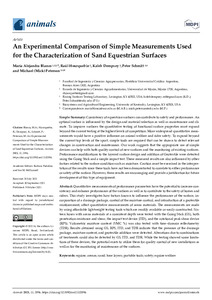Por favor, use este identificador para citar o enlazar este ítem:
https://repositorio.uca.edu.ar/handle/123456789/15125| Campo DC | Valor | Lengua/Idioma |
|---|---|---|
| dc.contributor.author | Blanco, María Alejandra | es |
| dc.contributor.author | Hourquebie, Raúl | es |
| dc.contributor.author | Dempsey, Kaleb | es |
| dc.contributor.author | Schmitt, Peter | es |
| dc.date.accessioned | 2022-10-03T08:20:55Z | - |
| dc.date.available | 2022-10-03T08:20:55Z | - |
| dc.date.issued | 2021 | - |
| dc.identifier.citation | Blanco, M. A. et al. An experimental comparison of simple measurements used for the characterization of sand equestrian surfaces [en línea]. Animals. 2021, 11. doi: 10.3390/ani11102896. Disponible en: https://repositorio.uca.edu.ar/handle/123456789/15125 | es |
| dc.identifier.issn | 2076-2615 | - |
| dc.identifier.uri | https://repositorio.uca.edu.ar/handle/123456789/15125 | - |
| dc.description.abstract | Abstract: Consistency of equestrian surfaces can contribute to safety and performance. An optimal surface is influenced by the design and material selection as well as maintenance and climate. To improve surfaces the quantitative testing of functional surface properties must expand beyond the current testing at the highest levels of competition. More widespread quantitative measurements would have a positive influence on animal welfare and rider safety. To expand beyond the current top levels of the sport, simple tools are required that can be shown to detect relevant changes in construction and maintenance. Our work suggests that the appropriate use of simple devices can help with both quality control of new surfaces and the monitoring of existing surfaces. Performance modifications to the layered surface design and addition of Geotextile were detected using the Going Stick and a simple impact test. These measured results are also influenced by other factors related to the surface condition such as moisture. Caution must be exercised in the interpretation of the results since these tools have not been demonstrated to correlate to either performance or safety of the surface. However, these results are encouraging and provide a justification for future development of this type of equipment. Quantitative measurements of performance parameters have the potential to increase consistency and enhance performance of the surfaces as well as to contribute to the safety of horses and riders. This study investigates how factors known to influence the performance of the surface, incorporation of a drainage package, control of the moisture control, and introduction of a geotextile reinforcement, affect quantitative measurements of arena materials. The measurements are made by using affordable lightweight testing tools which are readily available or easily constructed. Sixteen boxes with arena materials at a consistent depth were tested with the Going Stick (GS), both penetration resistance and shear, the impact test device (ITD), and the rotational peak shear device (RPS). Volumetric moisture content (VMC %) was also tested with time–domain reflectometry (TDR). Results obtained using GS, RPS, ITD, and TDR indicate that the presence of the drainage package, moisture content, and geotextile addition were detected. Alterations due to combinations of treatments could also be detected by GS, ITD, and TDR. While the testing showed some limitations of these devices, the potential exists to utilize them for quality control of new installations as well as for the monitoring of maintenance of the surfaces. | es |
| dc.format | application/pdf | es |
| dc.language.iso | eng | es |
| dc.publisher | Multidisciplinary Digital Publishing Institute | es |
| dc.rights | Acceso abierto | * |
| dc.rights.uri | http://creativecommons.org/licenses/by-nc-sa/4.0/ | * |
| dc.source | Animals. 2021, 11 | es |
| dc.subject | EQUINOS | es |
| dc.subject | ARENA | es |
| dc.subject | HERRAMIENTAS PORTÁTILES | es |
| dc.subject | SEGURIDAD | es |
| dc.subject | BIENESTAR EQUINO | es |
| dc.title | An experimental comparison of simple measurements used for the characterization of sand equestrian surfaces | es |
| dc.type | Artículo | es |
| dc.identifier.doi | 10.3390/ani11102896 | - |
| uca.disciplina | CIENCIAS AGRARIAS | es |
| uca.issnrd | 1 | es |
| uca.affiliation | Fil: Blanco, María Alejandra. Pontificia Universidad Católica Argentina. Facultad de Ingeniería y Ciencias Agropecuarias; Argentina | es |
| uca.affiliation | Fil: Blanco, María Alejandra. Universidad de Morón. Escuela de Ingeniería y Ciencias Agroalimentarias; Argentina | es |
| uca.affiliation | Fil: Blanco, María Alejandra. Racing Surfaces Testing Laboratory; Estados Unidos | es |
| uca.affiliation | Fil: Hourquebie, Raúl. Universidad de Morón. Escuela de Ingeniería y Ciencias Agroalimentarias; Argentina | es |
| uca.affiliation | Fil: Dempsey, Kaleb. Racing Surfaces Testing Laboratory; Estados Unidos | es |
| uca.affiliation | Fil: Schmitt, Peter. Racing Surfaces Testing Laboratory; Estados Unidos | es |
| uca.affiliation | Fil: Schmitt, Peter. University of Kentucky. Biosystems and Agricultural Engineering; Estados Unidos | es |
| uca.version | publishedVersion | es |
| item.fulltext | With Fulltext | - |
| item.grantfulltext | open | - |
| item.languageiso639-1 | en | - |
| Aparece en las colecciones: | Artículos | |
Ficheros en este ítem:
| Fichero | Descripción | Tamaño | Formato | |
|---|---|---|---|---|
| experimental-comparison-simple.pdf | 1,6 MB | Adobe PDF |  Visualizar/Abrir |
Visualizaciones de página(s)
76
comprobado en 27-abr-2024
Descarga(s)
39
comprobado en 27-abr-2024
Google ScholarTM
Ver en Google Scholar
Altmetric
Altmetric
Este ítem está sujeto a una Licencia Creative Commons

